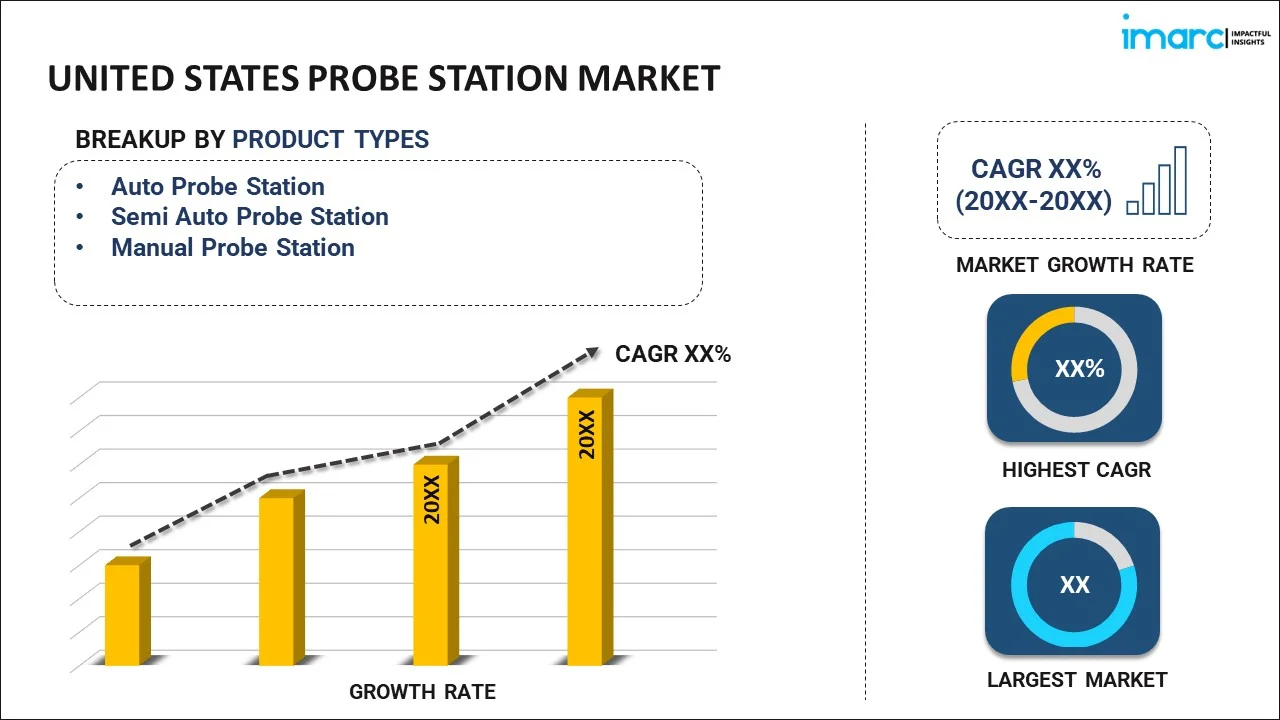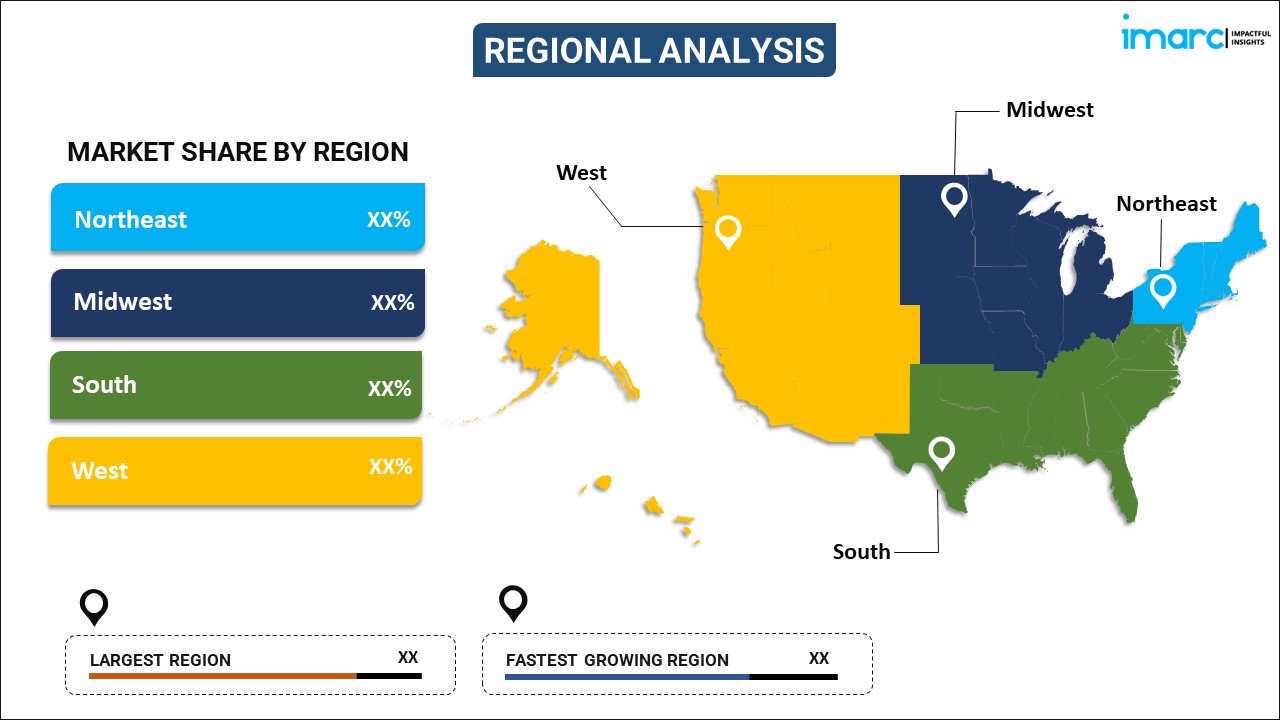
United States Probe Station Market Report by Product Type (Auto Probe Station, Semi Auto Probe Station, Manual Probe Station), Application (Semiconductor, Microelectronics, Optical Electronics, Photoelectric, and Others), Measurement Application (RF Probe Station, DC Probe Station, Active Probe Station), Distribution Channel (Direct Sale, Indirect Sales), End User (Hospitals and Clinics, Research Institutes, and Others), and Region 2025-2033
Market Overview:
The United States probe station market size reached USD 332.2 Million in 2024. Looking forward, IMARC Group expects the market to reach USD 779.2 Million by 2033, exhibiting a growth rate (CAGR) of 8.9% during 2025-2033.
|
Report Attribute
|
Key Statistics
|
|---|---|
|
Base Year
|
2024
|
|
Forecast Years
|
2025-2033
|
|
Historical Years
|
2019-2024
|
|
Market Size in 2024
|
USD 332.2 Million |
|
Market Forecast in 2033
|
USD 779.2 Million |
| Market Growth Rate (2025-2033) | 8.9% |
A probe station refers to a device used for acquiring signals along with testing circuits and devices with different semiconductors. It is primarily equipped with various equipment, such as thermal monitor systems, specific cables, and calibration software for supporting the positioning and characterization of testing devices. Probe station can be widely classified into three major types, including auto probe station (fully automatic), semi auto probe station, and manual probe station. Based on diverse complexities of testing procedures, these stations are adopted for numerous applications ranging from basic continuity inspection to advanced full functional scanning of micro-circuits.
In the United States, the rising investments in extensive R&D activities across the fields of electronics, material science, astronomy, etc., are currently driving the demand for probe stations. Furthermore, the growing popularity of RF-based probe stations due to their enhanced efficiency, easy setup, cost-effectiveness, compact size, etc., is also propelling the market. Additionally, a significant growth of the optical electronics and telecommunication sectors is further augmenting the demand for probe stations in the United States. These stations are extensively used in the testing of optical fibers and integrated devices for autonomous vehicles, network infrastructures, consumer electronics, etc. Apart from this, several technological advancements have led to the introduction of advanced product variants offering accurate measurements for higher-frequency applications with improved productivity. This is further expected to drive the market for probe stations in the United States over the forecasted period.
Key Market Segmentation:
IMARC Group provides an analysis of the key trends in each sub-segment of the United States probe station market report, along with forecasts at the country and regional level from 2025-2033. Our report has categorized the market based on product type, application, measurement application, distribution channel and end user.
Breakup by Product Type:

- Auto Probe Station
- Semi Auto Probe Station
- Manual Probe Station
Breakup by Application:
- Semiconductor
- Microelectronics
- Optical Electronics
- Photoelectric
- Others
Breakup by Measurement Application:
- RF Probe Station
- DC Probe Station
- Active Probe Station
Breakup by Distribution Channel:
- Direct Sale
- Indirect Sales
Breakup by End User:
- Hospitals and Clinics
- Research Institutes
- Others
Breakup by Region:

- Northeast
- Midwest
- South
- West
Competitive Landscape:
The competitive landscape of the industry has also been examined with some of the key players being Everbeing Int’l Corp., FormFactor Inc, Hprobe, KeyFactor Systems Inc., Lake Shore Cryotronics Inc, Micronics Japan Co. Ltd., MPI Corporation, The Micromanipulator Company, Tokyo Electron U.S. Holdings Inc. (Tokyo Electron Limited) and Wentworth Laboratories Inc.
Report Coverage:
| Report Features | Details |
|---|---|
| Base Year of the Analysis | 2024 |
| Historical Period | 2019-2024 |
| Forecast Period | 2025-2033 |
| Units | Million USD |
| Segment Coverage | Product Type, Application, Measurement Application, Distribution Channel, End User, Region |
| Region Covered | Northeast, Midwest, South, West |
| Companies Covered | Everbeing Int’l Corp., FormFactor Inc, Hprobe, KeyFactor Systems Inc., Lake Shore Cryotronics Inc, Micronics Japan Co. Ltd., MPI Corporation, The Micromanipulator Company, Tokyo Electron U.S. Holdings Inc. (Tokyo Electron Limited) and Wentworth Laboratories Inc. |
| Customization Scope | 10% Free Customization |
| Post-Sale Analyst Support | 10-12 Weeks |
| Delivery Format | PDF and Excel through Email (We can also provide the editable version of the report in PPT/Word format on special request) |
Key Questions Answered in This Report
The United States probe station market was valued at USD 332.2 Million in 2024.
We expect the United States probe station market to exhibit a CAGR of 8.9% during 2025-2033.
The growing need for efficient testing of semiconductor devices and optical fibers, along with the introduction of advanced product variants that offer accurate measurements for higher-frequency applications with improved productivity, is primarily driving the United States probe station market.
The sudden outbreak of the COVID-19 pandemic had led to the implementation of stringent lockdown regulations across the nation, resulting in the temporary closure of numerous manufacturing units for probe stations.
Based on the product type, the United States probe station market can be categorized into auto probe station, semi auto probe station, and manual probe station. Currently, manual probe station holds the majority of the total market share.
Based on the application, the United States probe station market has been segregated into semiconductor, microelectronics, optical electronics, photoelectric, and others, where semiconductor currently exhibits a clear dominance in the market.
Based on the measurement application, the United States probe station market can be divided into RF probe station, DC probe station, and active probe station. Currently, RF probe station accounts for the majority of the total market share.
Based on the distribution channel, the United States probe station market has been bifurcated into direct sale and indirect sales. Among these, direct sale currently holds the largest market share.
Based on the end user, the United States probe station market can be segmented into hospitals and clinics, research institutes, and others. Currently, hospitals and clinics exhibit a clear dominance in the market.
On a regional level, the market has been classified into Northeast, Midwest, South, and West, where Midwest currently dominates the United States probe station market.
Some of the major players in the United States probe station market include Everbeing Int’l Corp., FormFactor Inc, Hprobe, KeyFactor Systems Inc., Lake Shore Cryotronics Inc, Micronics Japan Co. Ltd., MPI Corporation, The Micromanipulator Company, Tokyo Electron U.S. Holdings Inc. (Tokyo Electron Limited), and Wentworth Laboratories Inc.
Need more help?
- Speak to our experienced analysts for insights on the current market scenarios.
- Include additional segments and countries to customize the report as per your requirement.
- Gain an unparalleled competitive advantage in your domain by understanding how to utilize the report and positively impacting your operations and revenue.
- For further assistance, please connect with our analysts.
 Inquire Before Buying
Inquire Before Buying
 Speak to an Analyst
Speak to an Analyst
 Request Brochure
Request Brochure
 Request Customization
Request Customization




.webp)




.webp)












